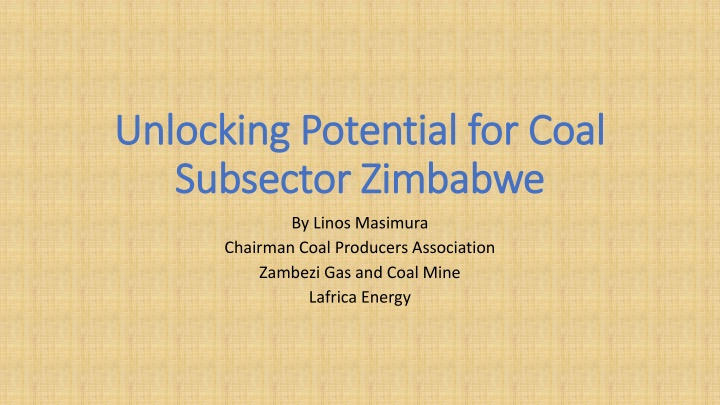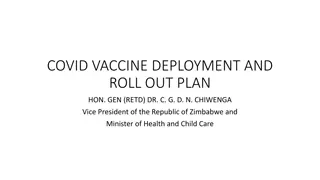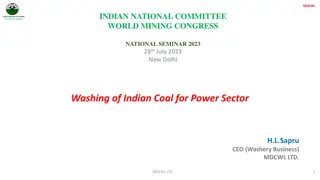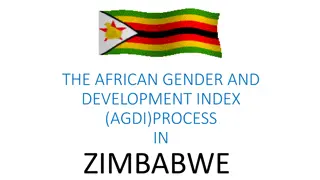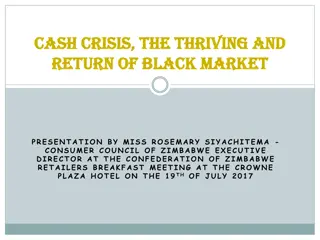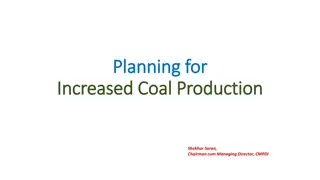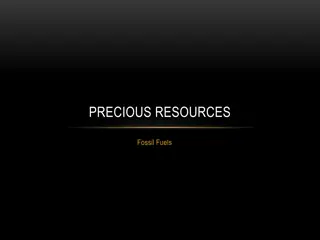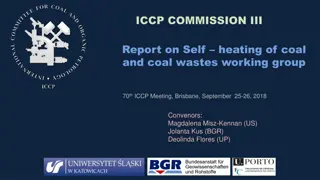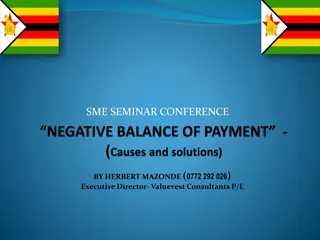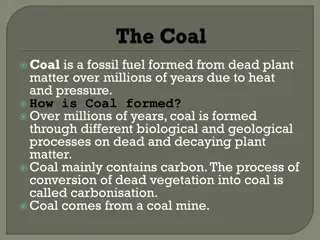Unlocking Potential for Coal Subsector in Zimbabwe: Insights by Linos Masimura
Linos Masimura, Chairman of the Coal Producers Association in Zimbabwe, highlights the growth in the coal sector with more than 6 operating mines by 2023. He emphasizes the need for stable electricity supply, currency stability, policy consistency, accessible financing, fair payment terms, and access to overseas markets to maximize the sector's potential.
Download Presentation

Please find below an Image/Link to download the presentation.
The content on the website is provided AS IS for your information and personal use only. It may not be sold, licensed, or shared on other websites without obtaining consent from the author.If you encounter any issues during the download, it is possible that the publisher has removed the file from their server.
You are allowed to download the files provided on this website for personal or commercial use, subject to the condition that they are used lawfully. All files are the property of their respective owners.
The content on the website is provided AS IS for your information and personal use only. It may not be sold, licensed, or shared on other websites without obtaining consent from the author.
E N D
Presentation Transcript
Unlocking Potential for Coal Unlocking Potential for Coal Subsector Zimbabwe Subsector Zimbabwe By Linos Masimura Chairman Coal Producers Association Zambezi Gas and Coal Mine Lafrica Energy
Coal Sector in Zimbabwe Coal Sector in Zimbabwe Before 2017 there were 2 operating Coal Mines By end of 2017 there were 3 operating coal mines As of 2023 there is more than 6 operating coal mines The sector has grown and continues to grow and we have seen operations starting in Chiredzi, Binga as new coal fields Current Markets : ZESA ( Major client 50-60% of coal mined) Coke batteries, Chrome Smelters , Platinum producers, Farmers, sugar industry Export to Zambia and DRC Overseas Market Not yet tapped due to lack of logistics solutions
Mining is one of the most important pillars of the Zimbabwean economy at around 12 percent of the GDP. The attainment of the USD 12 billion mining economy by 2023 depends on the mining players reaching their full potential in both capacity utilization and efficiency. What is needed for mining players to reach full capacity, and to have efficiency levels which are comparable to other countries producing similar minerals immediately : 1. Sufficient and stable local electricity supply. ZESA did a study according to Executive Chairman where they have concluded that one dollar spent on local generation inputs is equivalent to four dollars spent on electricity imports. There is need for local banks to support financially and deliberately electricity generation locally. There is need for ZESA to pay coal producers in USD an economic enabler just like fuel to make sure the economy has enough electricity supply for fellow miners and the general economy. 50-60% of the coal mined is suitable for electricity generation. 2. A stable local currency to remove input price distortions and encourage savings and building of strong balance sheet. Profitability of mining companies would be improved if the local currency is stable and predictable. 3. Policy consistency from monetary authorities is needed for miners to be able to budget and follow their budgets. Frequent changes in policy make it difficult for companies to make investment and expansion decisions leading to conservative decisions dominating board and management meetings. 4. Accessible and well communicated mining financing facilities where the evaluation is more on project potential and less on past history as most of the projects to enable the emergence of new projects from existing players as well as new players. 5. Equal treatment on payment terms by ZESA to all suppliers, for many years as Chairman of Coal Producers Committee I have been fighting to have a situation where one supplier was exchanging their United states electricity bill for coal supply amounting to payment in USD when others were paid 100% ZWL. This went on for more than 2 years and just recently ZESA has started paying in USD to the rest of the players, but one player had an unfair advantage for a long-time selling coal to the same market. 6. Opening of overseas export markets by having rail and port capacity of 10 million tons per year, NRZ need to refurbish existing assets in addition to acquiring additional assets to move 10 million of coal per annum. This will put Zimbabwe on the supply map of coal to global markets. With an open market more players can join and grow the sector and bring foreign currency for the economy. At an average price of $65 per ton for industrial coal the economy could generate USD650 million per annum. 7. Value addition financing like coke oven battery, coal to liquids and chemicals value addition .
Action Items: Collaboration of the Coal Producers and NRZ to action and finance refurbishment and purchasing of railway assets. Agreement with Beira port to have a section dedicated to coal export for Zimbabwe with facilities to offload coal by both rail and trucks in the port (currently trucks cannot offload in the port) Engagement with ZESA through the Chamber for payment consistence and assurance of USD payment for coal supplies in the future. Engagement of Banks through the Association for coal mining specific mining facilities to help expansion and new projects. Recognition of coal producers as economic enablers by RBZ and Ministry of Finance the same way they recognize supply of fuel.
Coal remains a critical resource for Zimbabwe and our transition to other forms of energy need to be balanced between environmental needs as well as supply security. Clean coal technologies on the use of coal for power generation are now in place so future power generation should use clean coal technologies like CFB boilers instead of Pulverised Boilers for example
